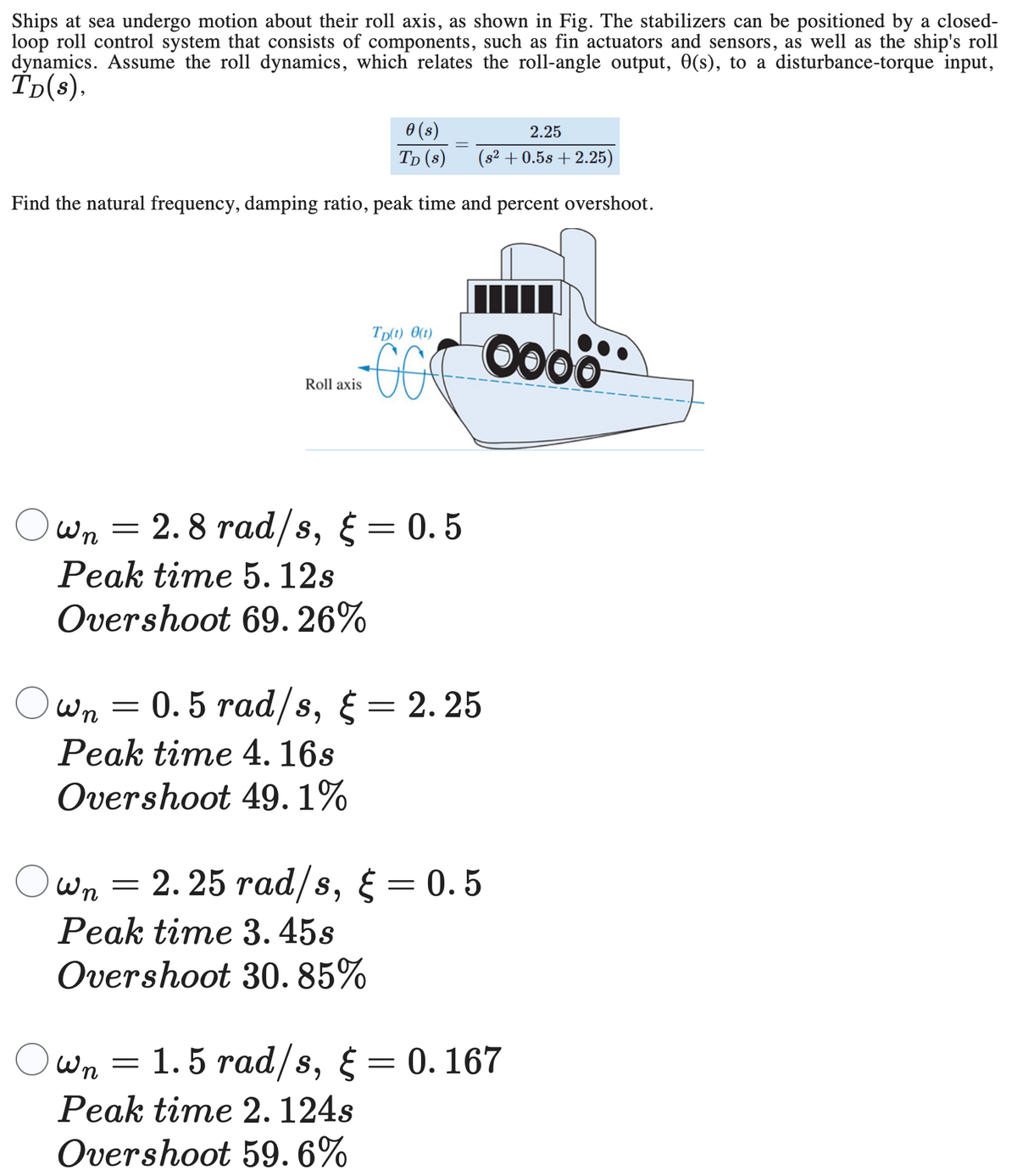Ships at sea undergo motion about their roll axis, as shown in Fig. The stabilizers can be positioned by a closed- loop roll control system that consists of components, such as fin actuators and sensors, as well as the ship's roll dynamics. Assume the roll dynamics, which relates the roll-angle output, 0(s), to a disturbance-torque input, ÏD(s), 0 (s) 2.25 TD (s) (s² +0.5s +2.25) Find the natural frequency, damping ratio, peak time and percent overshoot. =
Ships at sea undergo motion about their roll axis, as shown in Fig. The stabilizers can be positioned by a closed- loop roll control system that consists of components, such as fin actuators and sensors, as well as the ship's roll dynamics. Assume the roll dynamics, which relates the roll-angle output, 0(s), to a disturbance-torque input, ÏD(s), 0 (s) 2.25 TD (s) (s² +0.5s +2.25) Find the natural frequency, damping ratio, peak time and percent overshoot. =
Principles of Heat Transfer (Activate Learning with these NEW titles from Engineering!)
8th Edition
ISBN:9781305387102
Author:Kreith, Frank; Manglik, Raj M.
Publisher:Kreith, Frank; Manglik, Raj M.
Chapter6: Forced Convection Over Exterior Surfaces
Section: Chapter Questions
Problem 6.32P
Related questions
Question
Ships at sea undergo motion about their roll axis, as shown in Fig. The stabilizers can be positioned by a closed-loop roll control system that consists of components, such as fin actuators and sensors, as well as the ship's roll dynamics. Assume the roll dynamics, which relates the roll-angle output, θ(s), to a disturbance-torque input, TD(s)
Find the natural frequency, damping ratio, peak time and percent overshoot.
Question 5 options:
|
|
ωn=2.8 rad/s, ξ=0.5Peak time 5.12sOvershoot 69.26% |
ωn=0.5 rad/s, ξ=2.25Peak time 4.16sOvershoot 49.1% |
ωn=2.25 rad/s, ξ=0.5Peak time 3.45sOvershoot 30.85% |
|

Transcribed Image Text:Ships at sea undergo motion about their roll axis, as shown in Fig. The stabilizers can be positioned by a closed-
loop roll control system that consists of components, such as fin actuators and sensors, as well as the ship's roll
dynamics. Assume the roll dynamics, which relates the roll-angle output, 0(s), to a disturbance-torque input,
TD(s),
0 (s)
2.25
TD (s) (s² +0.5s +2.25)
Find the natural frequency, damping ratio, peak time and percent overshoot.
Own
Roll axis.
wn = 2.8 rad/s, = 0.5
§
Peak time 5.12s
Overshoot 69.26%
-
Tp(t) 0(t)
CCC
Oooo
0.5 rad/s, § = 2.25
&
Peak time 4. 16s
Overshoot 49.1%
wn = 2.25 rad/s, = 0.5
Peak time 3. 45s
Overshoot 30.85%
wn = 1.5 rad/s, § = 0.167
Peak time 2. 124s
Overshoot 59.6%
Expert Solution
This question has been solved!
Explore an expertly crafted, step-by-step solution for a thorough understanding of key concepts.
Step by step
Solved in 3 steps

Knowledge Booster
Learn more about
Need a deep-dive on the concept behind this application? Look no further. Learn more about this topic, mechanical-engineering and related others by exploring similar questions and additional content below.Recommended textbooks for you

Principles of Heat Transfer (Activate Learning wi…
Mechanical Engineering
ISBN:
9781305387102
Author:
Kreith, Frank; Manglik, Raj M.
Publisher:
Cengage Learning

Principles of Heat Transfer (Activate Learning wi…
Mechanical Engineering
ISBN:
9781305387102
Author:
Kreith, Frank; Manglik, Raj M.
Publisher:
Cengage Learning